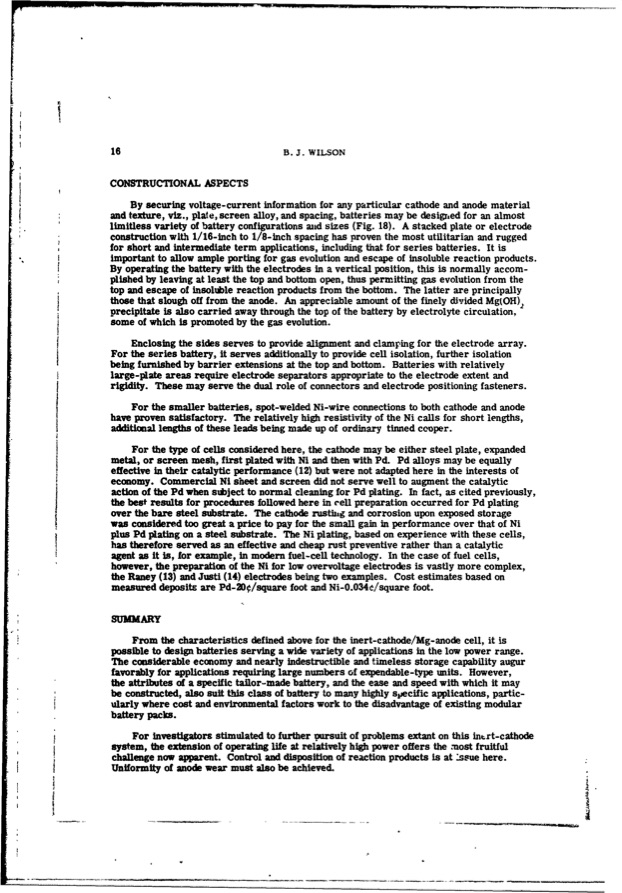
PDF Publication Title:
Text from PDF Page: 019
16 B. J. WILSON CONSTRUCTIONAL ASPECTS By securing voltage-current information for any particular cathode and anode material and texture, viz., plate, screen alloy, and spacing, batteries may be desigred for an almost limitless variety of battery configurations mid sizes (Fig. 18). A stacked plate or electrode construction with 1/16-inch to 1/8-inch spacing has proven the most utilitarian and rugged for short and intermediate term applications, including that for series batteries. It is important to allow ample porting for gas evolution and escape of insoluble reaction products. By operating the battery with the electrodes in a vertical position, this is normally accom- plished by leaving at least the top and bottom open, thus permitting gas evolution from the top and escape of insoluble reaction products from the bottom. The latter are principally those that slough off from the anode. An appreciable amount of the finely divided MgIOH)2 precipitate is also carried away through the top of the battery by electrolyte circulation, some of which is promoted by the gas evolution. Enclosing the sides serves to provide alignment and clampjing for tie electrode array. For the series battery, it serves additionally to provide cell isolation, further isolation being furnished by barrier extensions at the top and bottom. Batteries with relatively large-plate areas require electrode separators appropriate to the electrode extent and rigidity. These may serve the dual role of connectors and electrode positioning fasteners. For the smaller batteries, spot-welded Ni-wire connections to both cathode and anode have proven satisfactory. The relatively high resistivity of the Ni calls for short lengths, additional lengths of these leads being made up of ordinary tinned cooper. For the type of cells considered here, the cathode may be either steel plate, expanded metal, or screen mesh, first plated with Ni and then with Pd. Pd alloys may be equally effective in their catalytic performance (12) but were not adapted here in the interests of economy. Commercial Ni sheet and screen did not serve well to augment the catalytic action of the Pd when subject to normal cleaning for Pd plating. In fact, as cited previously, the best results for procedures followed here in cell preparation occurred for Pd plating over the bare steel substrate. The cathode rusthig and corrosion upon exposed storage was considered too great a price to pay for the small gain in performance over that of Ni plus Pd plating on a steel substrate. The Ni plating, based on experience with these cells, has therefore served as an effective and cheap rust preventive rather than a catalytic agent as it is, for example, in modern fuel-cell technology. In the case of fuel cells, however, the preparation of the Ni for low overvoltage electrodes is vastly more complex, the Raney (13) and Justi (14) electrodes being two examples. Cost estimates based on measured deposits are Pd-20¢/square foot and Ni-0.034t/square foot. SUMMARY From the characteristics defined above for the inert-cathode/Mg-anode cell, it is possible to design batteries serving a wide variety of applications in the low power range. The considerable economy and nearly indestructible and timeless storage capability augur favorably for applications requiring large numbers of expendable-type units. However, the attributes of a specific tailor-made battery, and the ease and speed with which it may be constructed, also suit this class of battery to many highly specific applications, partic- * ularly where cost and environmental factors work to the disadvantage of existing modular battery packs. For investigators stimulated to further pursuit of problems extant on this intrt-cathode system, the extension of operating life at relatively high power offers the most fruitful challenge now apparent. Control and disposition of reaction products is at :ssue here. Uniformity of anode wear must also be achieved.PDF Image | INERT-CATHODE SEA-WATER BATTERY

PDF Search Title:
INERT-CATHODE SEA-WATER BATTERYOriginal File Name Searched:
AD0673399.pdfDIY PDF Search: Google It | Yahoo | Bing
Product and Development Focus for Salgenx
Redox Flow Battery Technology: With the advent of the new USA tax credits for producing and selling batteries ($35/kW) we are focussing on a simple flow battery using shipping containers as the modular electrolyte storage units with tax credits up to $140,000 per system. Our main focus is on the salt battery. This battery can be used for both thermal and electrical storage applications. We call it the Cogeneration Battery or Cogen Battery. One project is converting salt (brine) based water conditioners to simultaneously produce power. In addition, there are many opportunities to extract Lithium from brine (salt lakes, groundwater, and producer water).Salt water or brine are huge sources for lithium. Most of the worlds lithium is acquired from a brine source. It's even in seawater in a low concentration. Brine is also a byproduct of huge powerplants, which can now use that as an electrolyte and a huge flow battery (which allows storage at the source).We welcome any business and equipment inquiries, as well as licensing our flow battery manufacturing.| CONTACT TEL: 608-238-6001 Email: greg@salgenx.com | RSS | AMP |